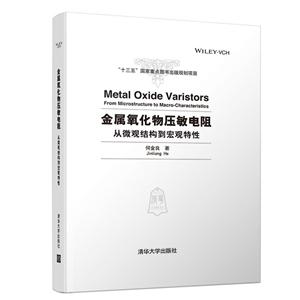-
>
中医基础理论
-
>
高校军事课教程
-
>
毛泽东思想和中国特色社会主义理论体系概论(2021年版)
-
>
中医内科学·全国中医药行业高等教育“十四五”规划教材
-
>
中医诊断学--新世纪第五版
-
>
中药学·全国中医药行业高等教育“十四五”规划教材
-
>
中医外科学——全国中医药行业高等教育“十四五”规划教材
金属氧化物压敏电阻:从微观结构到宏观特性 METAL OXIDE VARISTORS-FROM MICROSTRUCTU 版权信息
- ISBN:9787302533368
- 条形码:9787302533368 ; 978-7-302-53336-8
- 装帧:平装-胶订
- 册数:暂无
- 重量:暂无
- 所属分类:>>
金属氧化物压敏电阻:从微观结构到宏观特性 METAL OXIDE VARISTORS-FROM MICROSTRUCTU 本书特色
金属氧化物压敏电阻是电力和电子系统的关键保护器件,直接决定系统运行的安全可靠性。本书系统介绍了氧化锌等压敏电阻的基础研究、制备工艺、性能调控及应用进展,包括导电及老化机理、微结构电特性、微结构测试及微结构仿真分析、高梯度低残压氧化压敏陶瓷、氧化钛及氧化锡等其他体系压敏陶瓷的研究进展等,构建了压敏电阻微结构特性与宏观特性之间的关联性。 本书可供高校和科研院所电气工程、微电子、材料等专业的师生以及电力传输、电气设备制造等行业的工程技术人员阅读和参考。
金属氧化物压敏电阻:从微观结构到宏观特性 METAL OXIDE VARISTORS-FROM MICROSTRUCTU 内容简介
金属氧化物压敏电阻是电力和电子系统的关键保护器件,直接决定系统运行的安全可靠性。本书系统介绍了氧化锌等压敏电阻的基础研究、制备工艺、性能调控及应用进展,包括导电及老化机理、微结构电特性、微结构测试及微结构仿真分析、高梯度低残压氧化压敏陶瓷、氧化钛及氧化锡等其他体系压敏陶瓷的研究进展等,构建了压敏电阻微结构特性与宏观特性之间的关联性。 本书可供高校和科研院所电气工程、微电子、材料等专业的师生以及电力传输、电气设备制造等行业的工程技术人员阅读和参考。
金属氧化物压敏电阻:从微观结构到宏观特性 METAL OXIDE VARISTORS-FROM MICROSTRUCTU 目录
1.1 ZnOVaristors 1
1.2 FabricationofZnOVaristors 3
1.2.1 PreparationofRawMaterials 4
1.2.2 SinteringofZnOVaristors 5
1.3 Microstructure 6
1.4 TypicalParametersofZnOVaristors 7
1.5 HistoryofZnOVaristors 9
1.6 ApplicationsofZnOVaristors 12
1.7 AlternativeVaristorCeramics 17
1.8 Ceramic–PolymerCompositeVaristors 18 References 22
2 Conduction Mechanisms of ZnO Varistors 31
2.1 Introduction 31
2.2 BasicConceptsinSolid-StatePhysics 33
2.2.1 AtomicEnergyLevelandEnergyBandofCrystal 33
2.2.2 Metal,Semiconductor,andInsulator 35
2.2.3 CharacteristicsofFermi–DiracFunction 37
2.2.4 ImpurityandDefectEnergyLevel 38
2.3 EnergyBandStructureofaZnOVaristor 39
2.3.1 EnergyBandStructureofaZnOGrain 39
2.3.2 DSBofaZnOVaristor 40
2.3.3 MicroscopicOriginofDSB 41
2.3.4 Asymmetric I–V CharacteristicsoftheDSB 43
2.4 ConductionMechanismofaZnOVaristor 45
2.4.1 ConductionModelBasedonThermionicEmissionProcess 46
2.4.2 MinorityCarrierGenerationProcess 49
2.4.3 TheBypassE?ectModel 51
2.5 DielectricCharacteristicsofaZnOVaristor 51
2.5.1 ExplanationtoDielectricPropertiesofaZnOVaristor 52
2.5.2 E?ectofInterfacialChargeRelaxationonConductingBehaviorofZnOVaristorsUnderTime-VaryingElectricFields 54
2.5.3 DeterminationofBarrierHeightandRelatedParameters 58
2.5.4 DeterminationofDeepDonorLevelintheZnOVaristor 59
2.5.5 DeterminationofGrainandGrainBoundaryConductivity 60 References 62
3 Tuning Electrical Characteristics of ZnO Varistors 67
3.1 Introduction 67
3.2 Liquid-PhaseFabrication 68
3.2.1 MicrostructureofZnOVaristor 68
3.2.2 PolymorphofBismuthOxide 71
3.2.3 In?uenceofBi2O3Concentration 72
3.2.4 VolatilizationofBismuthOxide 72
3.3 PreparingandSinteringTechniques 74
3.3.1 Fabrication 74
3.3.2 FabricationStages 75
3.3.3 E?ectofPores 76
3.4 RoleofOxygenattheGrainBoundary 78
3.5 DopantE?ects 79
3.5.1 E?ectsofAdditives 79
3.5.2 DonorDopants 82
3.5.3 AcceptorDopants 86
3.5.4 AmphotericDopants 87
3.5.4.1 MonovalentDopants 88
3.5.4.2 TrivalentDopants 89
3.5.5 E?ectsofRareEarthOxides 92
3.5.6 DopantsforImprovingtheStability 93
3.5.7 EvidenceforHydrogenasaShallowDonor 95
3.6 RoleofInversionBoundaries 95
3.7 HighVoltageGradientZnOVaristor 98
3.8 LowResidualVoltageZnOVaristor 101
3.8.1 ResidualVoltageRatio 101
3.8.2 LowResidualVoltageZnOVaristorsbyDopingAl 103
3.8.3 LowResidualVoltageZnOVaristorsbyDopingGa 106
3.8.4 LowResidualVoltageZnOVaristorswithHighVoltageGradient 108 References 110
4 Microstructural Electrical Characteristics of ZnO Varistors 125
4.1 Introduction 125
4.2 MethodstoDetermineGrainBoundaryParameters 126
4.2.1 TheIndirectMethod 126
4.2.2 TheDirectMicrocontactMethods 126
4.3 StatisticalCharacteristicsofGrainBoundaryParameters 129
4.3.1 NonuniformityofBarrierVoltages 129
4.3.2 DistributionofBarrierVoltage 131
4.3.3 DistributionofNonlinearCoe?cient 132
Contents
4.3.4 DistributionofLeakageCurrentThroughGrainBoundary 133
4.3.5 DiscussiononMicrocontactMeasurement 133
4.4 Classi?cationofGrainBoundaries 134
4.5 OtherTechniquestoDetectMicrostructurallyElectricalPropertiesofZnOVaristors 137
4.5.1 ScanningProbeMicroscopy-BasedTechniques 137
4.5.2 GalvanicDeterminationofConductiveAreasonaVaristor Surface 139
4.5.3 LineScanDeterminationofDi?erencesinBreakdownVoltageWithinaVaristor 141
4.5.4 CurrentImagesinSEM 141
4.6 TestonFabricatedIndividualGrainBoundary 142
4.6.1 ThinFilmApproach 143
4.6.2 SurfaceIn-Di?usionApproach 143
4.6.3 BicrystalApproach 143 References 145
5 Simulation on Varistor Ceramics 149
5.1 Introduction 149
5.2 GrainBoundaryModel 151
5.2.1 I–V CharacteristicModelofGrainBoundary 151
5.2.2 GBModelConsideringConductionMechanism 154
5.3 SimulationModelof I–V Characteristics 159
5.3.1 Simple2DSimulationModel 159
5.3.2 2DSimulationModelsBasedontheVoronoiNetwork 161
5.3.3 ConsiderationonPoresandSpinels 164
5.3.4 AlgorithmtoSolveEquivalentCircuit 165
5.3.5 ModelVeri?cation 169
5.4 SimulationModelforThermalCharacteristics 170
5.4.1 ThermalConductionAnalysis 171
5.4.2 Pulse-InducedFractureAnalysis 173
5.5 SimulationsonDi?erentPhenomena 174
5.5.1 SimulationonMicrostructuralNonuniformity 174
5.5.2 SimulationonCurrentLocalizationPhenomenon 175
5.5.3 In?uenceofMicrostructuralParametersonBulkCharacteristics 179
5.5.3.1 In?uenceofZnOGrainParameters 180
5.5.3.2 In?uenceofGrainBoundaryParameters 183
5.5.4 In?uentialFactorsonResidualVoltageRatio 186 References 188
6 Breakdown Mechanism and Energy Absorption Capability of ZnO Varistor 193
6.1 Introduction 193
6.2 ImpulseFailureModesofZnOVaristors 194
6.3 MechanismsofPunctureandFractureFailures 197
6.3.1 MechanismsofPunctureFailure 197
6.3.2 MechanismofFractureFailure 201
6.4 SimulationofPunctureandFractureFailures 204
6.4.1 PunctureDestructionSimulation 204
6.4.1.1 PunctureSimulationinMicrostructure 206
6.4.2 CrackingFailureSimulationinMicrostructure 208
6.5 Thermal Runaway 209
6.5.1 PowerLossofZnOVaristor 210
6.5.2 ThermalRunawayMechanism 210
6.5.3 TeststoEnsuretheThermalStabilityCharacteristics 213
6.6 In?uencesofDi?erentFactorsonFailuresofZnOVaristors 213
6.6.1 In?uenceofMicrostructuralNonuniformity 213
6.6.2 In?uenceofElectricalNonuniformityinMicrostructure 216
6.6.3 SimulationAnalysisonBreakdownModes 217
6.7 In?uentialFactorsonEnergyAbsorptionCapability 218
6.7.1 In?uenceoftheAppliedCurrent 218
6.7.2 In?uenceofVaristorCross-sectionalArea 221
6.7.3 SimulationAnalysisonSurgeEnergyAbsorptionCapability 221
6.8 DiscussionsonEnergyAbsorptionCapability 225
6.8.1 EnergyAbsorptionCapabilityDeterminedbyFractureFailure 225
6.8.2 EnergyAbsorptionCapabilityDeterminedbyPunctureFailure 226
6.8.3 DiscussiononNonuniformityofEnergyAbsorptionCapability 228
6.8.4 AdditivesE?ectonEnergyAbsorptionCapability 229
6.8.5 OtherMeasurestoImproveEnergyAbsorptionCapability 230 References 230
7 Electrical Degradation of ZnO Varistors 235
7.1 Introduction 235
7.2 DegradationPhenomenaofZnOVaristors 237
7.2.1 DegradationPhenomenaoftheVaristorBulk 237
7.2.2 DegradationofGrainBoundary 242
7.2.3 PulseDegradationCharacteristics 245
7.2.4 TopographicInformationforDegradationAnalysis 247
7.3 MigrationIonsfortheDegradationofZnOVaristors 249
7.3.1 GrainBoundaryDefectModel 249
7.3.2 ExperimentalProofofIonMigration 251
7.3.3 Identi?cationofDominantMobileIons 252
7.3.4 Three-DimensionalExtension 256
7.4 DegradationMechanismofZnOVaristors 257
7.4.1 DCDegradationMechanism 258
7.4.2 ACDegradationMechanism 258
7.4.3 NonuniformDegradationMechanism 260
7.4.4 PulseDegradationofZnOVaristors 262
7.4.4.1 DegradationMechanismUnderImpulseCurrent 263
7.4.4.2 SuperimposingDegradation 264
7.5 RoleofInteriorMicrocracksonDegradation 266
7.6 AntidegradationMeasures 267
7.6.1 Speci?cPreparationProcedures 268
7.6.2 OptimizationofFormula 269
Contents
7.6.2.1 DopantE?ectsonImprovingACDegradationCharacteristics 270
7.6.2.2 DopantE?ectsonImprovingImpulseDegradationProperty 271 References 272
8 Praseodymium/Vanadium/Barium-Based ZnO Varistor Systems 281
8.1 PraseodymiumSystem 281
8.1.1 DopingE?ects 281
8.1.2 E?ectofSinteringProcesses 285
8.1.3 High-VoltageApplications 288
8.1.4 Low-VoltageApplications 288
8.2 VanadiumSystem 289
8.2.1 DopingE?ects 290
8.2.2 ElectricalCharacteristics 291
8.2.3 MicrostructuralCharacteristics 292
8.2.4 E?ectsofVanadiumOxideonGrainGrowth 294
8.3 BariumSystem 295
8.3.1 PreparationandElectricalCharacteristics 295
8.3.2 MicrostructuralCharacteristics 296
8.3.3 ImprovingStabilityAgainstMoisture 298
8.4 ZnO–GlassVaristor 298 References 300
9 Fabrications of Low-Voltage ZnO Varistors 307
9.1 Introduction 307
9.2 ExaggeratingGrainGrowthbySeedGrains 308
9.3 SynthesisofNanocrystallineZnOVaristorPowders 309
9.3.1 Gas-PhaseProcessingMethods 309
9.3.2 CombustionSynthesis 311
9.3.3 Sol–GelMethods 311
9.3.4 Solution-CoatingMethod 315
9.4 Nano?llersinZnOVaristorCeramics 320
9.5 SinteringTechniquestoControlGrainGrowth 321
9.5.1 Step-sinteringApproach 321
9.5.2 MicrowaveSinteringMethod 322
9.5.3 SparkPlasmaSinteringTechnique 324 References 327
10 Titanium-Based Dual-function Varistor Ceramics 335
10.1 SrTiO3 Varistors 335
10.1.1 Introduction 335
10.1.2 MicrostructureofSrTiO3Varistors 336
10.1.3 PreparationofSrTiO3Varistors 336
10.1.4 PerformanceofSrTiO3 338
10.1.5 ConductionMechanismofSrTiO3 339
10.2 TiO2-BasedVaristors 341
10.2.1 Introduction 341
10.2.2 PreparationofTiO2-BasedVaristors 342
10.2.3 MechanismofTiO2Capacitor–VaristorCeramics 342
10.2.4 DopingofTiO2-BasedVaristors 343
10.2.4.1 Acceptor-DopedTiO2-BasedVaristors 343
10.2.4.2 Donor-DopedTiO2-BasedVaristors 344
10.2.4.3 CodopingE?ectsofAcceptorandDonorDopants 345
10.2.4.4 SinteringAdditivesinTiO2-BasedVaristors 347
10.2.5 DevelopmentofTiO2-BasedVaristors 348
10.3 CaCu3Ti4O12 Ceramics 348
10.3.1 Introduction 348
10.3.2 StructureofCCTO 349
10.3.2.1 CrystalStructure 349
10.3.2.2 PhaseandMicrostructure 350
10.3.3 PerformancesofCCTOCeramics 352
10.3.3.1 NonohmicCurrent–VoltageCharacteristic 352
10.3.3.2 ColossalPermittivity 354
10.3.3.3 DielectricLoss 357
10.3.4 Mechanism 358
10.3.4.1 IBLCModel 358
10.3.4.2 ConductingMechanism 362
10.3.4.3 PolarizationMechanismofGrains 364
10.3.4.4 APolaronicStackingFaultDefectModel 365
10.3.5 RoleofDopants 366
10.3.5.1 RoleofDopingCuO 366
10.3.5.2 DopingMechanismstoTuneCCTOPerformances 368
10.4 BaTiO3VaristorsofPTCRE?ect 375
10.4.1 Introduction 375
10.4.2 DopingE?ects 377
10.4.3 PreparationofBaTiO3Ceramics 379
10.4.4 PTCRE?ectofBaTiO3Ceramics 381
10.4.5 VaristorCharacteristicsofBaTiO3Ceramics 384 References 386
11 Tin Oxide Varistor Ceramics of High Thermal Conductivity 407
11.1 PreparationofSnO2-BasedVaristors 407
11.2 ElectricalPerformancesofSnO2-BasedVaristors 410
11.3 MechanismofSnO2-BasedVaristors 414
11.3.1 FormationofGrainBoundaryPotentialBarrier 414
11.3.2 AtomicDefectModel 415
11.3.3 AdmittanceSpectroscopyAnalysis 417
11.3.4 Capacitance–VoltageAnalysis 420
11.3.5 E?ectofThermalTreatment 421
11.4 RoleofDopantsinTuningSnO2-BasedVaristors 423
11.4.1 DopantsforDensifyingSnO2-BasedVaristors 423
11.4.2 AcceptorDoping 424
Contents
11.4.3 DonorDoping 427
11.5 ThermalPerformances 429
11.6 DegradationBehaviors 431
11.7 DevelopmentofSnO2-BasedVaristors 432 References 434
12 WO3-Based Varistor Ceramics of Low Breakdown Voltage 441
12.1 Introduction 441
12.2 TungstenOxide 442
12.3 PreparationofWO3-BasedVaristors 444
12.4 ElectricalPerformances 446
12.5 ImprovingtheElectricalStability 448
12.6 MechanismModelofWO3-BasedVaristors 449
12.7 DopingE?ects 452
12.7.1 TheAdditionofRareEarthOxides 452
12.7.2 TheAdditionofCuO 453
12.7.3 TheAdditionofAl2O3 454
12.7.4 TheAdditionofTiO2 455
12.7.5 TheAdditionofOtherAdditives 455 References 456
Index 461
金属氧化物压敏电阻:从微观结构到宏观特性 METAL OXIDE VARISTORS-FROM MICROSTRUCTU 作者简介
何金良教授1994年在清华大学获得博士学位。于1994年4月开始在清华大学电机系任教,2001年提升为教授。1997年至1998年期间,为韩国电气研究所电材料部访问科学家。目前,他是清华大学高压研究所所长,主要从事电介质材料和电工陶瓷、避雷器技术、电力系统及电子系统的电磁暂态和电磁兼容、先进电能传输技术等方面的研究。
何金良教授在国际著名刊物发表论文130余篇,在中文核心期刊发表论文150余篇,在重要国际会议发表论文150余篇,同时合作编写6本专著及教材。获国家发明二等奖一次,省部级科技进步奖12项,是2008年亚太电磁环境国际会议暨第19届苏伊士电磁兼容国际会议优秀学生论文的合著者。
2007年因在电能传输系统的雷电防护和接地技术方面的杰出成就而被评为IEEE会士。2010年获得IEEE电磁兼容学会的“技术成就奖”,2011年获得IEEE电磁兼容学会的“致谢证书”。
何金良教授2004年荣获国家杰出青年基金,2010年被聘为教育部“长江学者特聘教授”。
胡军博士1998年、2000年、2008年在清华大学分获学士学位、硕士学位和博士学位。2008年开始在清华大学从事博士后研究,2010年8月开始在清华大学
- >
推拿
推拿
¥12.2¥32.0 - >
唐代进士录
唐代进士录
¥19.1¥39.8 - >
罗曼·罗兰读书随笔-精装
罗曼·罗兰读书随笔-精装
¥40.6¥58.0 - >
上帝之肋:男人的真实旅程
上帝之肋:男人的真实旅程
¥19.3¥35.0 - >
【精装绘本】画给孩子的中国神话
【精装绘本】画给孩子的中国神话
¥17.6¥55.0 - >
伯纳黛特,你要去哪(2021新版)
伯纳黛特,你要去哪(2021新版)
¥20.4¥49.8 - >
朝闻道
朝闻道
¥10.2¥23.8 - >
罗庸西南联大授课录
罗庸西南联大授课录
¥18.6¥32.0
-
家居设计解剖书
¥27.3¥39 -
网络安全基础
¥27.7¥39.5 -
家具造型设计
¥34.3¥49 -
工程硕士研究生英语基础教程学生用书
¥45.6¥68 -
国外电子与通信教材系列信号与系统(第二版)
¥69.3¥99 -
工程机械维修
¥30.8¥40















